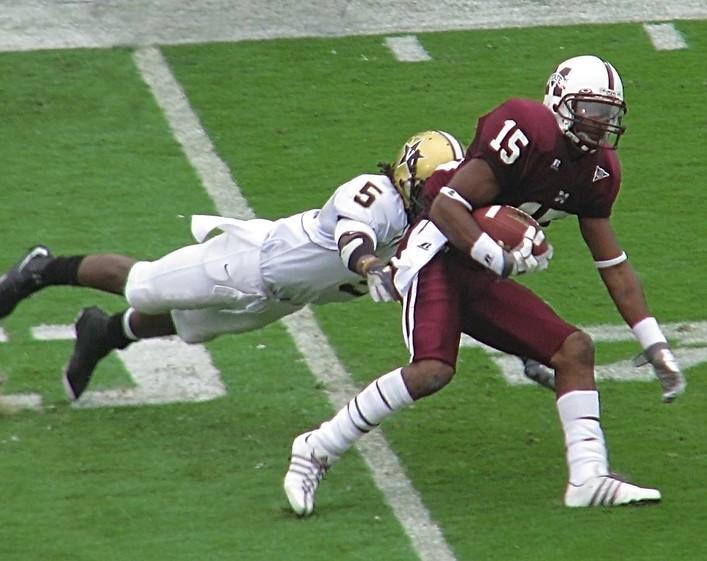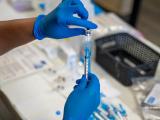COVID-19 didn't appear to spread efficiently within and among teams competing in the fall 2020 Southeastern Conference (SEC) college football season, finds an observational study published late last week in JAMA Network Open.
The study, led by a Texas A&M University researcher, analyzed close contacts (within 6 feet) among opposing players during official games and COVID-19 athlete testing data from Sep 26 to Dec 19, 2020.
At that time, cases were surging, but the more transmissible Delta (B1617.2) SARS-CoV-2 variant had not yet been identified in the United States. This may limit the findings' generalizability to pandemic phases since the emergence of Delta.
Most opposing-player contacts were fleeting
Over 64 SEC outdoor games, 1,190 college football players had 109,762 close contacts with opposing players. Contacts lasted, on average, 6 seconds (range, 1 to 380 seconds, with 95% shorter than 26 seconds).
Accumulated contact time between any two players during a single game averaged less than 23 seconds (median, 10 seconds; range, 1 to 1,558 seconds), and 95% of opponent pairs interacted for less than 97 seconds. Thirteen opponent pairs interacted longer than 15 minutes, but none tested positive for COVID-19 in the next 14 days.
Of the 1,190 players, 138 (11.6%) tested positive for COVID-19. Eighteen (1.5%) of them were diagnosed within 48 hours of a game; contact tracing showed that all 18 had close contact with opponents of 1 to 364 seconds (median, 12 seconds). No athletes tested positive for coronavirus over the next 14 days, so they weren't considered close-contact exposures per the current Centers for Disease Control and Prevention (CDC) definition.
The researchers said that some disease-mitigation efforts, like contact tracing, are complicated by the many brief close contacts between athletes during games and difficulty tracking and triaging athletes, especially with competitions involving more than one state, they added.
As a result, the National Collegiate Athletic Association (NCAA) declared football a high-risk sport for COVID-19 transmission, and each Power 5 conference developed its own protocols to stem transmission.
While the SEC didn't mandate masks or other personal protective equipment for athletes, it had them wear remote-proximity devices to automatically log their interactions during games. Also, athletes were tested for COVID-19 three or more times a week; those testing positive within 48 hours of a game were traced for possible exposures and infections over the next 14 days using the CDC definition of a close contact (at least 15 minutes within 6 feet of an infected person).
Confounding factors complicate interpretation
The authors noted several study limitations that necessitate further research. "For this particular paper, we looked at the player interaction, but we did not look at interactions that occurred between players and referees or players and coaches," lead author Benika Dixon, DrPH, MPH, said in a Texas A&M news release.
"We also looked strictly at gametime contact, so we didn't take into consideration any contacts that may have happened pre- or post-game."
The researchers concluded that, even during a pandemic, the transmission of infectious diseases can be monitored and prevented using multifaceted approaches melding traditional public health mitigation strategies and applied technologies.
"Active and vigilant surveillance can prevent introduction of SARS-CoV-2 or similar threats into game play and prevent game-specific exposures, transmission, and downstream infections and reduce stress on public health systems," they wrote. "Implications of sporting events and other game-related activities, such as training and travel, on SARS-CoV-2 transmission in athletic organizations and communities warrant more extensive analysis."
In a commentary in the same journal, KC Coffey, MD, MPH, and Daniel Morgan, MD, both of the University of Maryland in Baltimore, and Preeti Malani, MD, of the University of Michigan at Ann Arbor, said the low risk of transmission during the games could be attributed to short within-game interactions, outdoor venues, and the use of off-field mitigation strategies.
"There was spread of COVID-19 among team members, which reflected transmission risk in the community," they wrote. "If the extensive mitigation policies were not used, the study results may have been different. The testing protocol helped to reduce the number of student athletes with COVID-19 infection who reached the playing field, hence the opportunity of transmission between opposing teams was substantially decreased."
Coffey and colleagues said that previous studies have shown that many activities that appear risky are really on a continuum between safe and not safe in the context of COVID-19 becoming endemic.
"Striking a balance between resuming important activities (including athletics) without causing high rates of COVID-19 defines the new normal of endemic COVID-19," they concluded.
"[The authors] illustrate that outdoor activities are safer than indoor activities and brief contact is unlikely to transmit disease, especially when occurring alongside established public health interventions that mitigate higher-risk indoor activities."






















